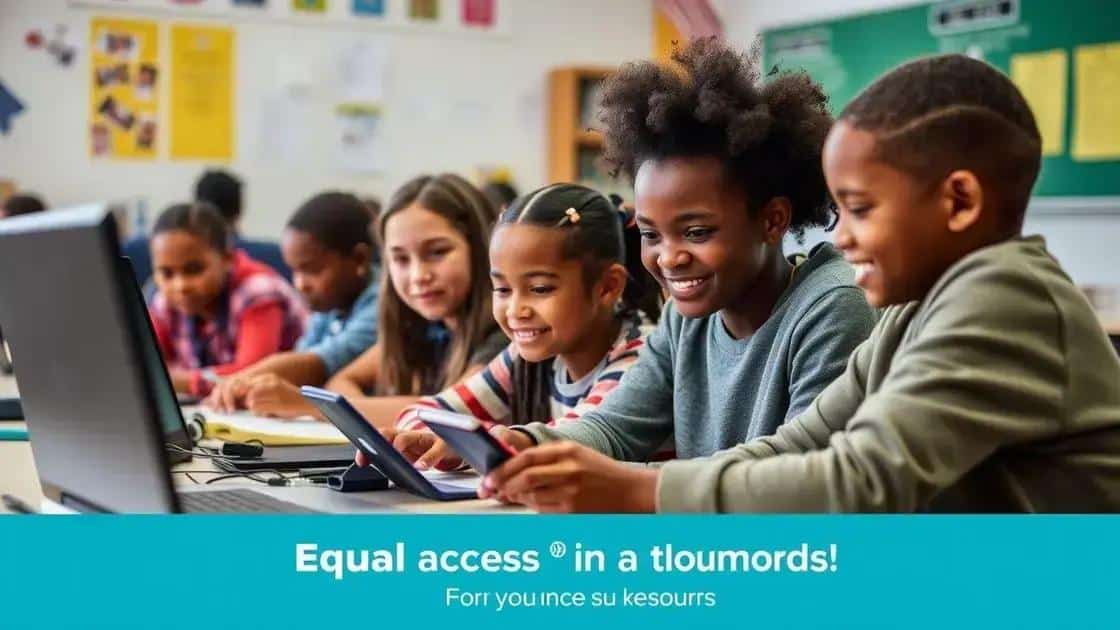Schools face deadline to end diversity initiatives
Anúncios
Schools face a deadline to end diversity initiatives under Trump guidelines, prompting significant discussions and legal challenges regarding educational equity and the future of inclusive practices.
Schools face deadline to end diversity initiatives under Trump guidelines, raising questions about the future of educational equity. How will schools adapt to these changes? Let’s explore the implications.
Understanding the Trump guidelines on diversity
Understanding the Trump guidelines on diversity is critical for schools today. These guidelines have changed the way diversity programs are implemented, affecting many aspects of the educational environment.
Initially, these guidelines aimed to allow schools more freedom in how they approached **diversity initiatives**. Schools were encouraged to assess their programs carefully. This reassessment was crucial as it pushed institutions to align their policies with federal expectations.
Key Changes in the Guidelines
Some of the key changes included a shift in focus. The guidelines emphasized individual merit over racial and ethnic diversity. This change prompted various reactions from educators and communities.
-
🍎 Reduction of Affirmative Action: Schools faced pressure to minimize affirmative action policies.
-
🏅 Focus on Merit-Based Policies: Emphasis was placed on individual abilities rather than group characteristics.
-
🔍 Increased Scrutiny: Educational programs started to undergo more thorough evaluations by federal authorities.
These adjustments highlight the complexities of promoting inclusion in the educational system. For many, the shift toward **merit-based approaches** raised concerns about its impact on student opportunities. How schools adapt to these guidelines has significant implications for their communities. Consequently, the dialogue surrounding these practices is more important than ever.
Furthermore, the ongoing discussions about the **importance of diversity** in education remain essential. Stakeholders, including parents, students, and educators, are tackling these challenges. Exploring the feedback from various communities can provide valuable insights into the effectiveness of these changes.
Impact of diversity initiatives in schools

The impact of **diversity initiatives in schools** is substantial and multifaceted. These initiatives are designed to create inclusive environments where all students can thrive. They play a crucial role in shaping the educational experience for students from various backgrounds.
Research has shown that when schools embrace diversity, the learning environment improves. Students learn to appreciate different perspectives, which enhances their critical thinking skills. This appreciation fosters respect among peers and encourages collaboration.
Benefits of Diversity Initiatives
Implementing diversity initiatives can lead to several key benefits for students and the school community. These efforts can:
- Enhance Social Skills: Students develop better communication and cooperation skills.
- Foster Academic Growth: A diverse environment can lead to improved problem-solving and creativity.
- Promote Equity: Such initiatives help ensure that all students have equal access to resources and opportunities.
Additionally, schools that actively promote diversity see lower levels of bullying and discrimination. This positive change helps create a safer and more welcoming atmosphere for everyone.
As students interact with peers from various backgrounds, they gain valuable insights and expand their worldview. This exposure is essential in preparing students for a global society. Educators often highlight the importance of these initiatives in their classrooms, integrating them into the curriculum effectively.
Moreover, the success of diversity initiatives relies on support from parents and the broader community. Collaboration between schools and families can amplify the positive effects of these programs. Engaged families who understand the value of diversity can reinforce these teachings at home.
Legal challenges surrounding diversity programs
The legal challenges surrounding **diversity programs** in schools have gained significant attention in recent years. As schools strive to implement these programs, they often face scrutiny and legal battles that can shape their policies and practices.
Many of these challenges stem from claims that diversity initiatives may violate the principles of equal treatment. Opponents argue that prioritizing certain demographics can lead to discrimination against others. This debate highlights the ongoing tension between promoting diversity and ensuring fairness.
Current Legal Cases
Several prominent legal cases have emerged that focus on the validity of diversity programs. These cases tend to revolve around specific arguments:
- Affirmative Action Policies: Many lawsuits challenge the use of race in admissions processes, claiming these practices disadvantage certain groups.
- Title IX Violations: Issues have arisen where students claim that diversity initiatives may conflict with their rights under Title IX.
- State Legislation: Some states have passed laws limiting or banning diversity programs, leading to legal disputes over their constitutionality.
These cases illustrate the significant impact of legal interpretations on how schools operate. Schools must carefully navigate these waters to ensure they comply with laws while striving to achieve diversity.
Moreover, changes in federal administration can further complicate the landscape for schools. Shifts in policy can lead to increased regulatory scrutiny or relaxed enforcement, impacting how diversity programs are viewed legally. Schools need to stay informed about these changes to adjust their strategies accordingly.
Engaging legal expertise is often crucial for schools to mitigate risks. By consulting with legal professionals, educational institutions can better understand their rights and responsibilities. This proactive approach can strengthen their diversity initiatives while addressing potential legal issues.
Alternative strategies for promoting inclusion

Alternative strategies for promoting **inclusion** in schools are essential in today’s educational landscape. As schools navigate the challenges posed by recent guidelines, they can adopt various innovative approaches to foster an inclusive environment.
One effective strategy is to implement **culturally relevant curriculum**. This approach ensures that students see themselves reflected in what they learn. When educators include diverse histories and perspectives, students become more engaged and feel valued.
Community Engagement
Another important aspect of fostering inclusion is by promoting community engagement. Schools can build partnerships with local organizations to support their inclusion efforts. Specific actions can include:
-
🌱 Workshops and Trainings: Organizing workshops for staff, students, and parents that focus on diversity and inclusion helps raise awareness.
-
👨👩👧👦 Parent Involvement: Encouraging parents to participate in school events creates a stronger, more connected community.
-
🎉 Cultural Celebrations: Hosting events that celebrate various cultures allows students to share and learn from one another.
Furthermore, schools can utilize **peer mentoring programs**. These programs can pair students from different backgrounds to promote understanding and friendship. When students work together, they build empathy and break down stereotypes.
Technology also plays a vital role in fostering inclusion. Utilizing digital tools can create more accessible learning environments. For example, online resources can help provide extra support to students who need it. Additionally, teachers can use educational apps that cater to diverse learning styles.
By integrating these strategies, schools can encourage a culture of inclusion. As educators seek to implement these methods, ongoing evaluation of their effectiveness is crucial. Schools can adapt and refine their approaches to better serve their students.
Community responses to the deadline
Community responses to the **deadline for diversity initiatives** vary widely, reflecting diverse opinions and emotions. As schools face pressures to comply with new guidelines, community members express both support and concern.
Some community groups advocate for the continuation of these initiatives, emphasizing their importance for fostering an inclusive environment. These supporters often highlight that diversity programs can lead to better educational outcomes for all students. They believe that maintaining such programs is crucial for promoting acceptance and understanding among different cultures.
Concerns from Parents and Students
On the other hand, some parents and students voice apprehension about how the changes will affect the classroom experience. They worry that ending diversity initiatives may result in:
- Reduced Support: Students from marginalized backgrounds may feel less supported in an environment that lacks dedicated diversity programs.
- Increased Discrimination: There are fears that minority students could face bullying or isolation without strong diversity policies in place.
- Lack of Representation: Ensuring that diverse voices are heard becomes challenging when programs are diminished.
Additionally, many community members are organizing discussions and forums to share their perspectives. These forums serve as safe spaces for individuals to discuss the implications of the deadline and to educate others about the value of diversity in education.
Some schools also respond proactively by reaching out to parents and community leaders to gather feedback. This engagement helps build trust and ensures that voices from all sides are heard. Creating an open dialogue fosters better understanding of the issues surrounding diversity initiatives and their potential impacts on students.
As communities navigate this complex situation, collaboration between schools, parents, and local organizations remains vital. Finding common ground can lead to more effective and inclusive educational practices for everyone involved.
Future implications for educational equity

The future implications for **educational equity** are closely tied to the ongoing debates surrounding diversity initiatives. As schools adapt to new regulations and guidelines, the way they approach inclusion will significantly impact students’ learning experiences.
One important aspect of educational equity is the accessibility of resources. Schools must ensure that all students, regardless of their background, have equal access to high-quality education. This accessibility can be threatened if diversity initiatives are scaled back, making it crucial for schools to find ways to maintain support systems for marginalized students.
Potential Changes in Policy
As states reevaluate their education policies, schools may face shifts that impact equity. Important considerations include:
- Funding Disparities: Changes in funding formulas could lead to unequal allocation of resources, affecting schools in lower-income areas more severely.
- Curriculum Adjustments: Schools may need to adapt their curricula to meet new guidelines while ensuring that diverse perspectives remain a core part of education.
- Increased Accountability: As educational equity becomes more prominent, schools may face greater scrutiny regarding their diversity practices.
Moreover, community engagement will play a significant role in shaping the future of educational equity. Schools that actively seek input from parents and community members can better address the needs of their students. Collaborative efforts can lead to innovative solutions that enhance equity within the educational system.
Technology might also influence future educational equity. With the rise of digital learning tools, there is potential to reach students who previously had limited access to quality education. However, this reliance on technology must consider disparities in access to devices and internet connections.
Ultimately, the commitment to maintaining educational equity depends on how schools respond to changing guidelines. By prioritizing inclusive practices and actively engaging with their communities, schools can work toward a more equitable future for all students.
FAQ – Frequently Asked Questions about Diversity Initiatives in Schools
What are diversity initiatives in schools?
Diversity initiatives in schools are programs and policies aimed at fostering an inclusive environment for students from various backgrounds.
Why are diversity programs important in education?
These programs promote understanding, respect, and collaboration among students, enhancing their academic and social experiences.
How can communities support diversity initiatives?
Communities can engage by attending school meetings, providing feedback, and collaborating with schools to enhance educational equity.
What challenges do schools face in maintaining diversity initiatives?
Schools often face legal pressures, funding disparities, and changing policies that can impact their ability to implement and sustain these initiatives.






